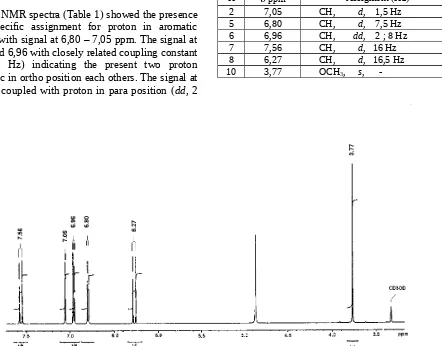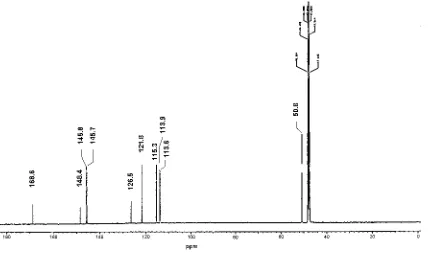Cinnamic Acid Derivate From the Bark of
Lerchea bracteata
Val.
Deddi P. Putra, R. Roza, Dachriyanus, Y. Alen and D. Arbain Dep.t of Pharmacy FMIPA University of Andalas
ABSTACT
Investigation of chemical constituen of the bark of Lerchea bracteata Val. has been carried out. A 3,4-dihyroxymethylcinnamic acid has been isolated and charactirezed from ethyl acetate fraction by chromatography methods and followed by recrystalization, obtained as yellowish crystalline and melted at 162-163 oC. The structure of this compound was elucidated from its
spectroscopic datas: UV, IR, H1 and C13 NMR spectra, 2D NMR (COSY, HMBC/HSQC) and as
well as mass spectra.
Keywords: Lerchea bracteata Val, Rubiaceae, 3,4-dihyroxymethylcinnamic acid
---INTRODUCTION
Lerchea bracteata Val (Rubiacece) is one of species growing in West Sumatra and locally named as “Sitapuang Rimbo”. No traditional value has been recorded so far. However, people in the region are used it occasionally for pain releaving or treatmen of skin illines. From our previous study, methanolic extract of the leaves were obtained a new quartenary alkaloid indol and named as Lerchein (I) (Arbain, et al, (1992) chemical constituent of this plant, the bark Lerchea bracteata Val was reinvestigated and the result leading to isolation of 3,4-dihyroxymethylcinnamic (II) is reported.
MATERIALS AND METHODS
General: Melting point was determined on Fisher melting point apparatus and uncorrected. Electronic spectra was determined from methanol solution using Shimatzu UV-VIS 1601 spectrophotometer. Infrared spectrum was recorded as potassium bromide disc using a Perkin-Elmer 1600 FTIR instrument. Proton and carbon NMR spectra were determined in DMSO on a Bruker AM300 spectrometer at 300 and 75 MHz, respectively.
Column chromatography was performed on silica gel G (Merck, 7743) and TLC on silica gel with indicator at 254 nm (Polygram Sil G/UV254, No.
805023).
Plant materials:The bark of Lerchea bracteata Val were collected from Kambang village on April 2003, Pesisir Selatan West Sumatra. A voucher specimen was deposited in Herbarium Biology-FMIPA, the University of Andalas (ANDA) with collection number DPP/004/2003.
Extraction and purification: The fresh bark (2 Kg) of Lerchea bracteata Val. where chopped into small pieces, were extracted with methanol for 3 days. Extraction was repeated twice more and the combined extracts were concentrated in vacuo to about 0.25 lt. The methanolic extract was then adjusted with distilled water to a volume of 0,5 lt and was triturated with hexane and then with ethyl acetate, successively, to separate non-polar compounds and semi polar alkaloid fraction. Water fraction was extracted with n-buthanol. All fraction were evaporated to dryness to give a residu non polar fraction (0,5 g), ethyl acetat fraction (2,1 g) and n-butanol fraction (3,2 g).
Two gram of ethyl acetat fraction were chromatographed on column chromatography using silica gel G and eluted successively with ethyl acetate-methanol mixes of increasing polarity. The fraction with similar Rf value on TLC was combined and rechromatographed using similar solvent system. One band (81 mg) which is still contain small impurities was purified with radial chromatography using n-heksan-chloroform afforded a
yellowish crystalline of 3,4-dihyroxymethylcinnamic (48 mg), m.p. 162-163 oC (compound II).
RESULTS AND DISCUSSION
The methanol extract of the stem of Lerchea bracteata was submitted to solvent partition and the ethyl acetate fraction was chromatographed over Si gel column using n-hexane with increasing polarity by ethyl acetate and then methanol. A major band with similar Rf value was combined and recromathographed ones more and then followed by radial chromathography. After recrystalization on n-hexane-chloroform, a yellowish needle of compound II was obtained(48 mg), m.p. 162-163 oC.
The structure of compound II was established from
1H and 13C NMR spectral data. The IR spectra of
(II) showed -OH fungtional group (3493 cm-1), a
carbonyl C=O which appear at lower frequency due to conjugate ethylen double bond (1681 cm-1) and
an C-H aromatic ring (3308 cm-1) and C=C
aromatic (1603 cm-1) (Harbone, 1994).
The UV
spectra (in MeOH) of (II) present the
absorption maxima at
328, 300, 244 and 219 nmshowing a characteristic UV absorption of
cinnamic derivate.
The 1H NMR spectra (Table 1) showed the presence
of specific assignment for proton in aromatic region with signal at 6,80 – 7,05 ppm. The signal at 6,80 and 6,96 with closely related coupling constant (d, 7,5 Hz) indicating the present two proton aromatic in ortho position each others. The signal at 6,96 is coupled with proton in para position (dd, 2
Hz) and this proton it self appear as singlet at 7,05 ppm. The signal siglet (s) at 3,77 ppm was –OCH3
with integration which is represent 3H. The methoxy was shifted to downfield due to the methyl link directly to carbonyl. Two similar doublet signals (d) with coupling constant quite large (16,5 Hz) was characteristic for proton ethylene in trans position and this assigment was confirmed by COSY data where H at 6.27 ppm has corelate with H at 7.56 ppm. (Fig.1.). aromatic region (a) and double bond ethylene group (b)
Fig. 2. 1-H NMR spectra of Compound II in CD 3OD
Fig.3 13C NMR of Compound II in CD 3OD
The 13C NMR spectrum (Table. 2, Fig.3.) showed
the presence of 10 atom carbon signals. The multiplicities of the carbons determine by DEPT led to the attribution of 4 C, 5 CH and 1 CH3. The signal at
168 ppm was attributed to carbonyl. The signals at 145.8 and 113.6 ppm were assigment for olefinic carbon double bond and their corelation with the proton signal at 7.56 and 6.27 ppm confirmed with HSQC data. As EI MS measurement showing gave the molecular formula (M+: 197.7), then
allowing us to propose the molecular formula C10H10O4 .
The HMBC spectra showing that the carbon signal at 50.8 ppm (CH3) was coupled with the
signal at 168.5 ppm confirming the methoxy attaced to carbon carbonyl. Overall, the structure of compound II is drown as follow:
HO
HO
O
OCH3
(II)
Table 2. 13C-NMR of Compound II in CD 3OD
C ppm Assigment
1 126.5 C
2 113.9 CH
3 145.7 C
4 148.4 C
5 115.3 CH
6 121.8 CH
7 145.8 CH
8 113.6 CH
9 168.6 C
10 50.8 O-CH3
Acknowledgments
The authors are thankful to Drs. Rusdi Tamin and Erlonaldi from Dept of Biology-FMIPA, the University of Andalas for identifying and collecting specimens as well as Prof. N Hj. Lajis from Institute Biosciences for providing necessary facilities on spectral data.
References
Arbain, D., D. P. Putra, M .H. Mukhtar dan R. Tamin (1999)., ‘Skrining Bioaktifitas Tumbuhan Taman Nasional Kerinci Seblat’, PSTO Unand-KEHATI.
Arbain, D., R. Tamin, M.H. Mukhtar and D.P. Putra, (2001), ‘Chemical study of biologically active constituents of Sumatran plants’, Report PPUPS-URGE.
Ardianto, A. (2001), Identifikasi berbagai spesies Lerchea di Sumatera Barat, Skripsi S1 Biologi, FMIPA Universitas Andalas.
Axelius, B., (1987), The Genus Lerchea (Rubiaceae), Blumea Vol. 32, Botaniska Instituonen Stockholm Universited, Stockholm, Sweden.
Arbain D.; N.H., Lajis, D.P. Putra, M.V. Sargent, B.W. Skelton and A.H. White, (1992), ‘New Quaternary Corynanthe Alkaloid from Lerchea bracteata Val.’, J. Chem. Soc., Perkin Trans 1, p. 3039-3042.
Meyer, B. N., N. R. Ferrigni, J. E. Putnam, L. B. Jacobsen, D. E. Nichols, and J. L. McLaughlin, (1982), Brine Shrimp : A Convenient General Bioassay for Active Plant Constituents, Plant Med., 45 : p. 31-34.
Malone, M.H. and A.C. Richard, (1977), ‘ Hippokratic and Pharmaceutical Screening’ In H.P. Wagner, New Natural Product and Plant with Pharmacological, Biological and Therapeutic Activity, Springer-Verlag, Berlin.

